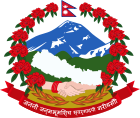- Nepalese Rastriya Panchayat election, 1981
-
Nepal 
This article is part of the series:
Politics and government of
NepalGovernment Political history · Constitution Executive President
Ram Baran YadavVice President
Parmanand JhaPrime Minister
Baburam BhattaraiCouncil of Ministers (List) Parliament Constituent Assembly Chairman
Subash Chandra NemwangVice Chairman
Purna Kumari SubediJudiciary Supreme Court Chief Justice
Khil Raj RegmiElections Election Commission
Constituent Assembly: 2008
Presidential: 2008Political parties Administrative divisions Capital
Regions
Zones
Districts
VDCs
Elections were held to the Rastriya Panchayat (National Council) in Nepal on 9 May 1981. 80% of the seats were elected through adult universal suffrage; this was the first election through universal suffrage held in Nepal in 22 years. However, political parties were banned at the time, and the main underground opposition forces (the Nepali Congress and various communist groups) called for a boycott of the election.[1]
The election were the first to be held after the 1980 constitutional amendment. In total there were 112 elected seats, whilst 28 were appointed by the King.[2] According to official reports, 63% of the eligible voters took part in the polls. However, there were some inconsistencies in the report of voting numbers.[3] Voter turnout was 52.2%.[4]
Contents
Constituencies
40 out of the 75 districts of Nepal formed two-member constituencies whilst the less populated 35 districts formed single-member constituencies.[5] The 15 mountain districts were all single-member constituencies. The hill districts elected 57 seats, the inner-terai districts eight seats and the terai districts 32 seats.[6]
Campaign
Initially there were 1,451 total candidates, of whom 353 later withdrew. 70 of the candidates, spread over 43 different districts, had also contested the 1959 parliamentary election.[6] Virtually all candidates campaigned on slogans such as "God and Motherhood", portraying themselves as opponents of corruption and inflation.[7] With the absence of organised political parties in the election, the campaign was rather low-scale. Mass rallies were not held, not even in Kathmandu. Most candidates relied heavily on door-to-door campaigning and canvassing through family, caste and ethnic networks. Candidates also used posters and vehicles with loudspeakers.[1] The spending ceiling of each candidate was fixed at 30,000 Nepalese rupees.[6]
Candidates had to pay a security deposit of 1,500 Nepalese rupees in order to contest the election.[6]
Results
Party Votes % Seats Independents 3,855,525 100 112 Invalid/blank votes 223,118 - - Total 4,078,643 100 112 Source: Nohlen et al, IPU The incumbent prime minister, Surya Bahadur Thapa, contested and was elected from the Dhankuta district. He got 40,546 votes in total. Two pre-panchayat prime ministers contested the election, Matrika Prasad Koirala and Dr. K.I. Singh. Matrika Prasad Koirala contested in the Morang district. He was supported, unofficially, by Surya Bahadur Thapa. Koirala did however lose the election, whilst K.I. Singh was elected.[8]
Overall, the result was a setback for the ruling elite. Although all candidates were officially independents, various candidates were well-known as having the backing of the government. In total about 70% of the "official" candidates lost their seats. In the elected Rastriya Panchayat, there were 57 newcomers to the assembly.[7]
The defeats of the officialist side was partially due to divisions inside the officialist camp. In Morang district the royal house and the prime minister supported opposing candidates, eventually resulting in the defeat for both.
The candidate who received the highest number of votes was Hem Bahadur Malla, a cabinet minister. Malla got 76,720 votes. The elected member with the lowest number of votes was Tej Bahadur Bham, who got 3,137 votes.[8]
Whilst the Nepali Congress leadership had called for boycott, the dissident fraction led by Bakhan Singh Gurung had launched 36 candidates. Four of them were elected; Dr. K.I. Singh, Bakhan Singh Gurung, Kashi Nath Gautam and Bhagwat Yadav. The pro-Soviet Communist Party led by Keshar Jung Rayamajhi had launched over 45-50 candidates, but none got elected.[7][8]
Some independent leftwing candidates were elected, such as Govinda Nath Upreti (Kavre), Rup Chandra Bista (Makwanpur) and Karna Bahadur Hyuju (Bhaktapur). Other independent supporters of reintroducing parliamentary democracy who were elected were Shribhadra Sharma, Arjun Narsingh K.C. and Prakash Chandra Lohani.[8]
Twenty-eight women candidates contested the election, out of whom two were elected; Nani Mainya Dahal and Bhadra Kumari Ghale.[8] Dahal, a relatively unknown person in Nepalese politics at the time, swept the Kathmandu district polls. Her election was seen as a mistrust vote against the establishment.[7]
References
- ^ a b Shaha, Rishikesh. Politics in Nepal 1980-1990. New Delhi: Manohar Publications, 1990. p. 106-107.
- ^ www.nepalelectionportal.org/EN/elections-in-nepal/electoral-history.php
- ^ Shaha, Rishikesh. Politics in Nepal 1980-1990. New Delhi: Manohar Publications, 1990. p. 110.
- ^ Nohlen, D, Grotz, F & Hartmann, C (2001) Elections in Asia: A data handbook, Volume I, p634 ISBN 019924958
- ^ Shaha, Rishikesh. Politics in Nepal 1980-1990. New Delhi: Manohar Publications, 1990. p. 108.
- ^ a b c d Gurung, Harka. The Sociology of Elections in Nepal, 1959 to 1981, published in Asian Survey, Vol. 22, No. 3, (Mar., 1982), pp. 304-314.
- ^ a b c d Panday, Devendra Raj. Nepal in 1981: Stagnation Amidst Change, published in Asian Survey, Vol. 22, No. 2, A Survey of Asia in 1981: Part II, (Feb., 1982), pp. 155-162.
- ^ a b c d e Shaha, Rishikesh. Politics in Nepal 1980-1990. New Delhi: Manohar Publications, 1990. p. 111.
Parliamentary elections Referendums Categories:- 1981 elections in Asia
- Elections in Nepal
- Non-partisan elections
- 1981 in Nepal
Wikimedia Foundation. 2010.
